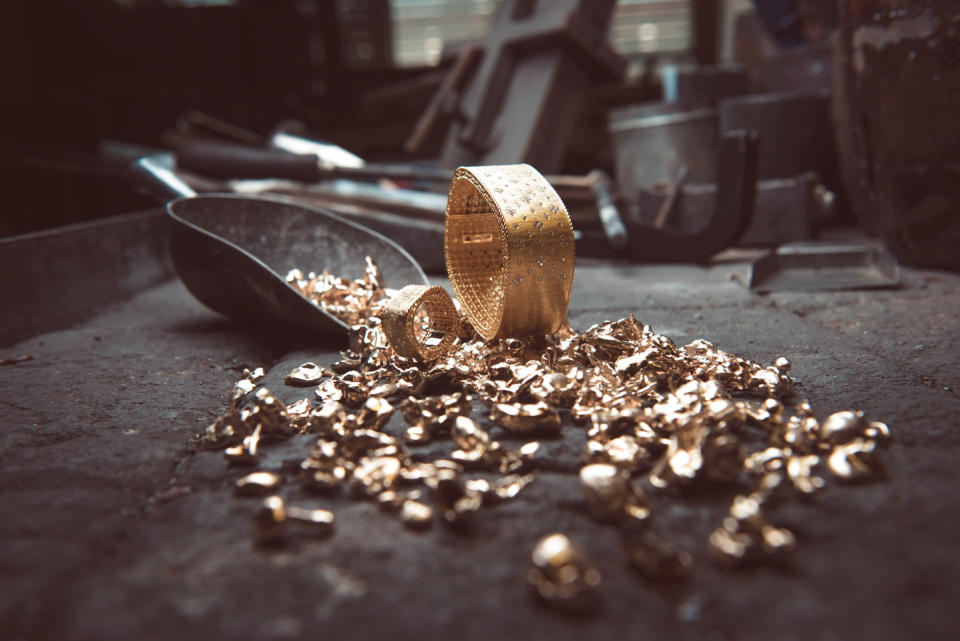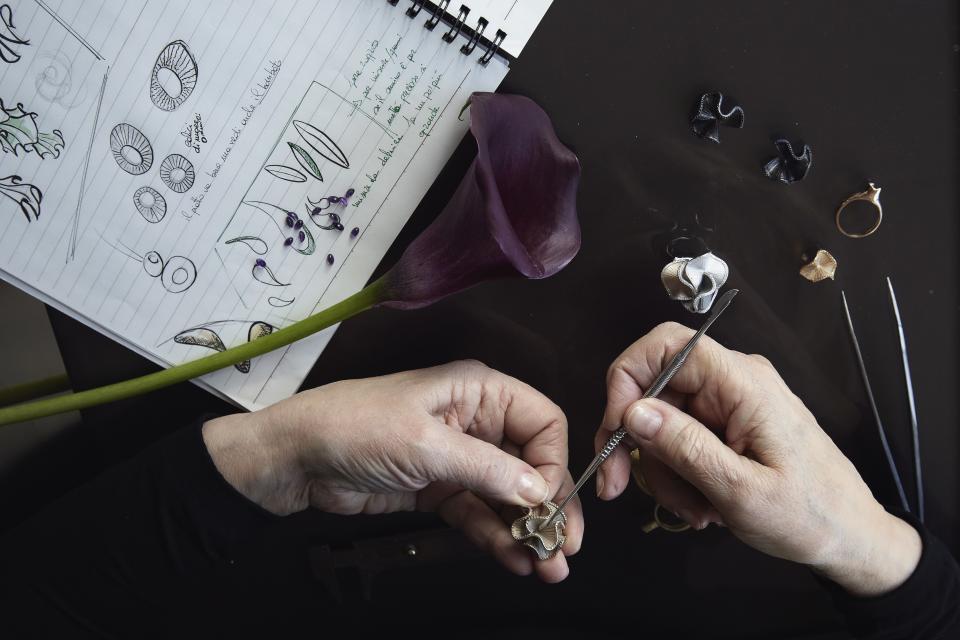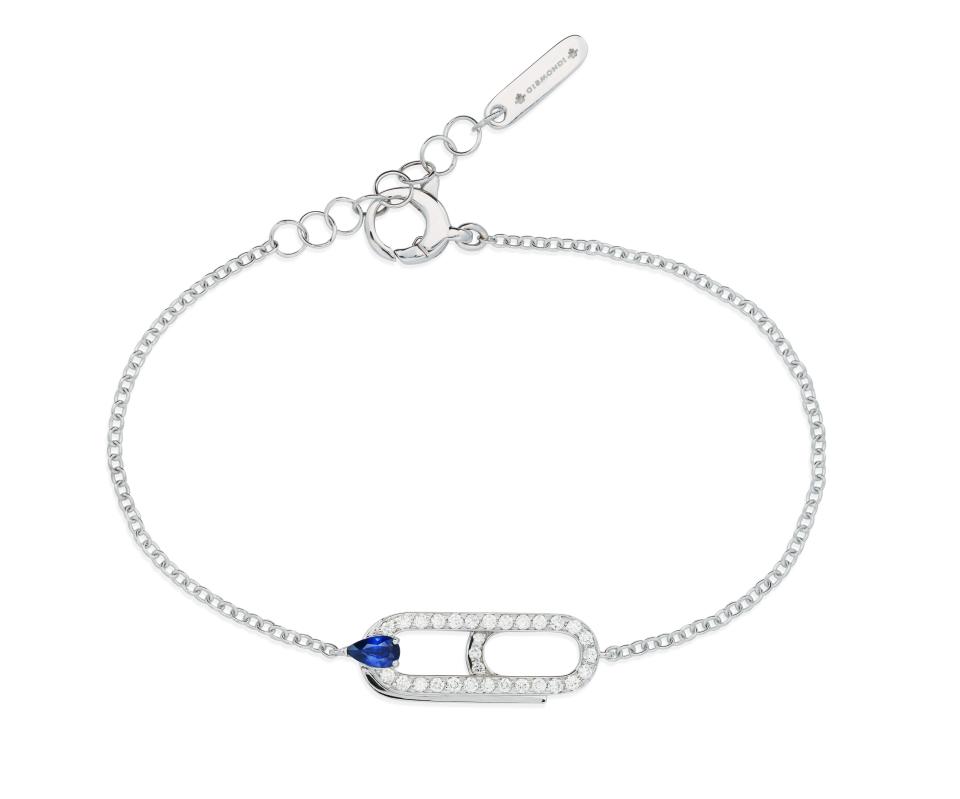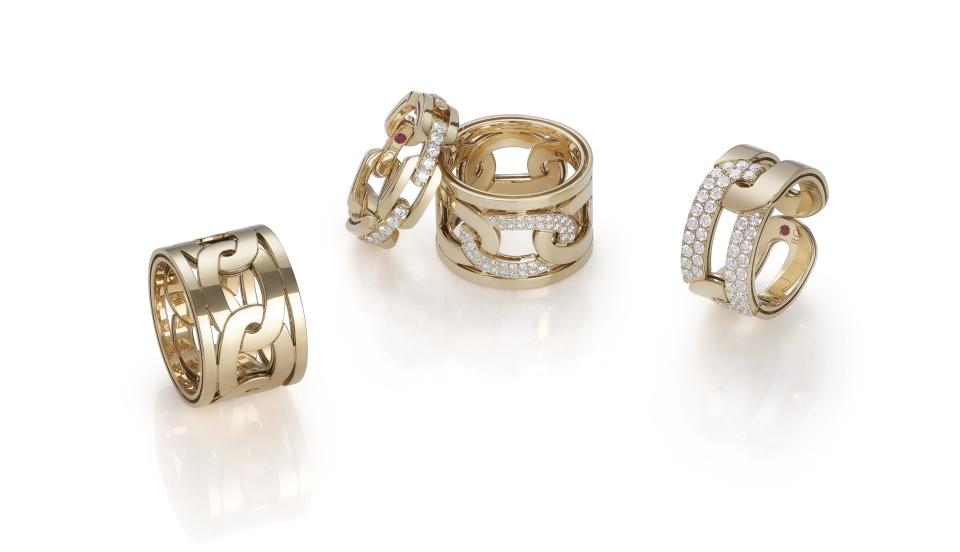Generational Turnover Trumps War in Business Concerns at VicenzaOro

VICENZA, Italy — Goldsmith students from professional academies mingled with buyers at VicenzaOro, the five-day trade show dedicated to jewelry that closed here on March 21.
They boosted the attendance at the fair, which was up 24 percent compared to the previous edition in September, with more than 300 buyers from 127 countries, led by Spain, Germany, the U.S., Greece and France.
More from WWD
The presence of students was a promising step that reassured exhibitors about one of their main concerns: the difficulty of attracting a new, younger workforce to the industry.
This topic was often at the top of jewelry brands’ agenda, taking priority even over the uncertainties linked to the war in Ukraine, rising energy costs, the spike in gold prices and the sourcing of precious stones.
As for the pandemic, it already seemed a thing of the past. Moreover, while COVID-19 might have slowed companies’ production and impacted logistics and raw material prices, it also turned out to be extremely profitable for the industry, which was one of the few sectors that benefited from the crisis as it is traditionally considered a safe-haven asset.

Courtesy of Roberto Coin
A Booming Industry
According to data released by Confindustria Moda’s research center on behalf of the national jewelry association Federorafi, in 2021 Italian companies’ sales totaled 8.8 billion euros, up 54.6 percent compared to the previous year and 11.9 percent versus 2019.
Export accounted for more than 90 percent of total sales and grew 59.7 percent to surpass the 8 billion euros benchmark last year. The U.S. was still the largest export market for Italian jewelry, accounting for 16 percent, and growing 65.6 percent compared to 2020. It was followed by Switzerland and the United Arab Emirates, where exports of Italian jewelry grew 49.5 percent and 107.7 percent, respectively.
“The past two years, and 2021 specifically, were a manna from heaven for jewelry companies,” said Roberto Coin, president of the Vicenza-based company. “In our case, we saw a positive trend starting from 2019 and COVID-19 just accelerated that,” he continued, adding that the product demand is now “almost double our production capacity. But the real question is: Will it stay like this?”
Massimo Gismondi, chief executive officer of the seven-generation, family-run company Gismondi 1754, believes it will as he confirmed that 2019 was “extraordinary and this year started in an incredible way, too.”
As of mid-February, the company reported sales of 1.81 million euros, already exceeding revenues totaled in the first quarter of 2021. Last year, the Genoa-based group grew revenues 48 percent to 9.74 million euros.
“This trend goes beyond the war. Customers in uncertain times buy more jewelry, it’s a psychological inclination that encourages you to enjoy an object that tomorrow you might not have the opportunity to enjoy,” said Gismondi, underscoring that the company is continuing to register sales from Ukrainian and Russian customers despite the invasion.
Even acknowledging the confusion and uncertainty surrounding the global situation, Giorgio Visconti’s CEO Andrea Visconti echoed that the company is “noticing a strong activity in all Eastern Europe.”
“It’s been 20 days that we’ve been receiving important requests from [Russia’s and Ukraine’s] neighboring countries, which also telegraph how a valuable good that is easy to transport quickly is a fundamental asset,” he said.
Without disclosing figures, Visconti revealed that last year his company’s sales grew between 80 and 90 percent compared to 2020 and 40 and 50 percent versus 2019.
“The market rebounded from July, after restrictions were lifted. And starting from September there was a spike in sales that we have never seen and I believe we’ll never see again. We concentrated all sales in six months,” Visconti said. In addition to the appeal of the category, sales drivers were the effort made in marketing activities and in improving the classic offering, as well as the successful launch of the new “Io Luce” line, which “put a big pressure on us in terms of production.”

Courtesy of Giorgio Visconti
Operational Challenges, Distribution Opportunities
While for Visconti the recent spike in energy costs won’t weigh significantly on production, as “we’re not working in big plants but small laboratories compared to other industries,” the sourcing and price increase of raw materials and components for machinery represent bigger concerns.
“All these elements slow down the supply chain and result in delays in productions,” confirmed Fiammetta de Simone of the Torre del Greco-based De Simone coral specialist. “The only solution is patience, which luckily we’re already armed with considering that our products depend on nature’s pace,” she added with a smile.
In this context, Russia’s role might be central again, being a key supplier of precious metals and diamonds, with the former’s value reported to be 890 million euros in 2021. The country is the second largest supplier of palladium, third of platinum and eighth for gold for Italian companies.
This exposure generated moral self-questioning by exhibitors, many of which said they would rather go through sourcing difficulties than purchase Russian gemstones and indirectly finance the war.
If Russia has some leverage regarding raw materials, on the exports front it represents only the 23rd largest market for Italy, 18th if grouped with Ukraine and Belarus. As a result, the area affected by the war accounts for just under 1 percent of Italian jewelry exports.
While de Simone said a bigger impact on companies might be registered indirectly, reporting retailers’ concerns as Russians are among the industry’s big spenders when traveling abroad, Gismondi maintained a more optimistic approach.
“When you’re in the top-of-the-range segment, there’s no fear of losing big spenders. You can have a slowdown in distribution but in our case, we have a very strong retail channel,” Gismondi said. On the contrary, the executive aims to further expand the wholesale network this year with the goal of consolidating the U.S. market — which is the firm’s best-performing one also due to private clients — as well as grow in Italy and Europe. Then, after establishing a strong presence in these areas, “we will start moving toward Asia, where the brand is getting increasingly recognized.”
Coin shared a similar strategy, highlighting that the U.S. and the Middle East are the key markets and the brand is slowly readying expansion in China. Meanwhile, Roberto Coin has opened a series of franchised stores, including one last month in Moscow’s Tsum, in addition to Dubai, Kuwait, Bahrain and Malaysia, and is eyeing a launch in Paris next year, too.
Even if the Giorgio Visconti brand will return to Japan next month after a 10-year hiatus thanks to a new distribution agreement, Visconti echoed that expansion in Europe is key. He specifically pointed to the potential of the Balkans, which are increasingly adding to the firms’ best-performing markets, including the Baltic countries, Spain and Portugal.

Courtesy of Roberto Coin
The Workforce Emergency
To sustain these distribution plans and booming demand, production is likely to be put under further pressure, therefore highlighting the importance of attracting younger artisans since 30 to 40 percent of the workforce will reach retirement age in a few years.
“We don’t have artisans and youth that want to work in this industry anymore,” said Visconti, stressing that the solution resides in enhancing the goldsmith culture, “which must be taught and passed down.”
“It’s a complex job, if you don’t love it, it’s very difficult to do it, plus it requires time. It’s a slow process that has to start from schools,” he continued, adding that his company tries to hire as many young talents as possible “evaluating them on their willingness to learn rather than techniques they still don’t have.”
For Coin, “habitat” is pivotal in this context, too. “A good goldsmith earns more than a bank director, so it’s not a matter of money…nor of a permanent contract. What do new generations want? They want to fall in love,” he said mentioning the importance of providing an exciting work environment. “If you think about it, this industry’s plants are ugly, maybe we should shake them up and make them more interesting.”
“New generations are more focused on other, tech paths, but here we’re teaching a job that can’t be replicated by machinery, so in the long lead they won’t be replaceable, and we need to communicate that,” Visconti said.
Lack of communication is at the source of the problem also for Alessia Crivelli, who is president of Fondazione Mani Intelligenti dedicated to training new talents for the industry, in addition of being head of marketing in the family company Crivelli.
“Everything that there is behind a product has never been told….Plus, for many people, working in a factory is perceived as a plan B when things don’t work out with other types of educational paths,” she said.
Working on a more immediate solution, Florence-based jewelry brand Annamaria Cammilli will launch an in-house academy this summer to train the sales staff of its partnering retailers on how to better communicate the values of the company and all the features behind its products. “It’s a first step to honor also the work of those who create our jewels,” said the company’s spokesperson Caterina Periccioli.

Courtesy of Annamaria Cammilli
Products: Polarizing Trends
Product-wise, two opposing trends surfaced at VicenzaOro.
On one end, couture creations got bolder, more colorful and precious then ever, to feed big spenders’ increasing demand for unique pieces. On the other end, a new minimalism informed diamond pieces in essential shapes to meet consumers’ desire for more everyday items as well as to attract a new generation of customers.

Courtesy of Annamaria Cammilli
Annamaria Cammilli presented both the “Les Petits” youthful line of delicate rings and pendants evoking stylized flowers and, for the first time, a high-end offering via the “Prestige” and “Couture” collections featuring colored gemstones such as emeralds, rubies and tanzanites.
In addition to its signature Princess collections, Roberto Coin presented the new Navarra line inspired by the royal coat of arms of the Spanish region, featuring 16 chains arranged in a halo and topped by a crown. Hence a collection dominated by chain designs on bangles, rings as well as movable earrings and necklaces, all rendered in yellow gold and diamonds.
At Gismondi 1754, the high-end Clip collection was reinterpreted with a simpler approach in the Clip Mia range, focusing on a paper clip-shaped motif offered in gold with a pink sapphire or covered in diamonds with a blue sapphire, among others. The Clip Sintesi line offered a more sinuous alternative with wavy rings and earrings in rose gold and diamonds.

Andrea Erdna Barletta/Courtesy of Gismondi 1754
In addition to beefing up the Io Luce line, which focuses on enhancing the brilliance of square- or drop-cut diamonds in essential settings, Giorgio Visconti presented another lightweight and youthful collection playing with sinuous, swirling silhouettes and gemstones in different colors, for which the company is still determining the name and positioning.
Since the feedback, de Simone received from retailers is to go even bigger with its signature flamboyant jewelry, the brand offered high-end corals and turquoise combined with diamonds and colored gems. “In this period, customers are looking even more for pieces that elicit an emotional reaction,” de Simone said.
If Gismondi confirmed the feeling, believing that “the design of a jewel accounts for 80 percent on a purchase,” for Crivelli the intrinsic value of materials employed in a piece is what attracts consumers today.
“The perception of jewelry has changed, it’s not only about the design but its value. Tennis bracelets and solitaire rings are going really strong and not just those of big brands, but all of them, as long as there’s a real value in its materials,” Crivelli said. The company’s new collection contained designs featuring hard stones such as malachite, carnelian, onyx, coral, turquoise and mother-of-pearl.

Courtesy of Roberto Coin
The Design Room, the section dedicated to independent designers, included the likes of Roman jewelry master Alessio Boschi’s statement pieces that could double as sculptures or design objects to display at home.
The namesake brand, which relocated to Bangkok almost a decade ago, showcased unique items, including a massive necklace reinterpreting Rome’s Piazza Navona via a total of 280 carats of Paraíba tourmaline stones — including a central gem that alone made for 80 carats — and a “Tree of Life” ring that replicated the four seasons through emeralds and sapphires, for an estimated retail value of $137,000.
In addition to functional features, such as precious earrings doubling as brooches or a majestic pearl and Paraíba necklace that can be worn in 16 different ways, Boschi introduced two exclusive, opulent rings that epitomized his craftsmanship and made for the first NFTs in VicenzaOro’s history. Taking seven months and 40 artisans to develop, the most striking one reproduced Persian architecture, concealing miniature — and moving — dancers under an expandable dome structure.
Sign up for WWD's Newsletter. For the latest news, follow us on Twitter, Facebook, and Instagram.

